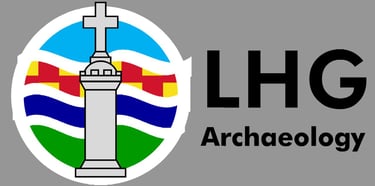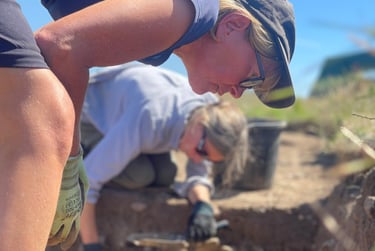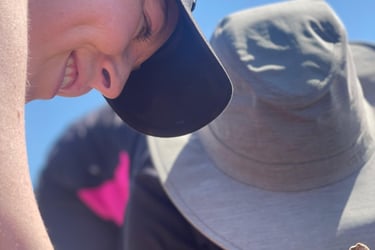Hunting Hall Archaeology Blog
A daily account of our Hunting Hall dig.


29th June 2025 : Dig Diary Day 28
This has been our last day on site for this year and so I think it’s appropriate that our resident professional archaeologist has the honour of writing our final dig diary. Thanks Kristian.
TRENCH 10
The excavations in Trench 10 extended our familiarity with the features that appeared when we were excavating both Trench 3 and Trench 5. We had encountered so much significant stone within the presumed palisade ditch that we could only infer that there was some re-use of these features through the duration of occupation of the site. This season we endeavoured to understand this palisade better, for we had encountered in Trench 9 last year on the other side of the site, and there was not nearly the same volume of stone or suggestions of re-use or adaptation to later phases of occupation. As we investigated this, we came upon a pit excavated into the palisade; above this was what can only be described as a rubble layer of mixed occupational debris. Perhaps an occupational phase was levelled, so another phase could be build atop this ? Whatever the sequence, we were able to determine through stratigraphy at least two phases after the palisade's existence: one represented by a pit, and above this the rubble. Fortunately, we recovered good organic evidence from the palisade in the form of mandibles and femurs from what is probably cattle. This ought to provide us with radiocarbon dates should they contain sufficient collagen.
Moving south of the palisade, there were peculiar cobble-filled ditches. At first, we assumed that they would follow a simple course; however, here our expectations were frustrated. It seems that one of them, orientated ENE-SWS, was recut on three separate occasions. The ditches were also going off in slightly different directions rendering correlation with what we could observe visually in plan difficult. To the west of this recutting complex, another cobble-filled ditch was investigated that was orientated somewhat differently from the aforementioned one. This also had a posthole cut into this, again suggesting multiple phases of occupation.
Along the western margin of the trench, where the putative 'ring' was studied, the ditches are again complex and evince indications of multiple cuttings. In this instance, though, on our final day, we discovered a lower horizon replete with organics impregnated into the soil. The ceramic that was recovered here was badly scorched, and we are presently uncertain whether this derives from the late Bronze Age or the Iron Age. Unfortunately, we could not investigate this any further so made the prudent decision to leave this feature for another season's investigations. We do not wish to compromise the preservation of organic material by introducing oxygen into sealed deposits.
TRENCH 8
This trench was far more complex and productive than was assumed last year. The ditch was cut into an extant organic deposit, likely a kettle hole. Organic horizons were sealed by a homogeneous clay fill, which we suspect represents the washing in of clay when the ditches-and-banks ceased to be maintained. Beneath this, though, was domestic detritus such as animal bone, a broken quernstone, and ceramics. The faunal material is rich and varied, ranging from bovine to smaller mammals. We have even recovered avian fauna and also limpet shells. The latter could only have been introduced by anthropogenic agency, and affords unusual evidence of maritime resource exploitation in the Iron Age. The surviving wooden stakes, placed in a vertical position, suggests that some sort of wattle fencing retained the clay bank while the site was in use.
OVERVIEW
Everyone put in splendid work this season, and we are most grateful to all of you for your contributions. As I am away through the summer, I very much look forward to us convening at 'GarageLab' in the autumn months to begin processing this extraordinary corpus of evidence. We leave, as ever, with more questions, but we have also solved some of the conundrums that faced us earlier regarding phasing the site. I am still very much disposed to regard this as a prosaic agricultural settlement, but one that was resilient insofar as it could adapt its activities to the changing political and economic landscape of the Romano-British frontier zone.
For my part and on behalf of Lowick Heritage Group, I’d like to thank everyone who has taken part this year. So many volunteers including a significant number of new people who joined us for their first experience of this enjoyable, healthy and convivial outdoor hobby. So good too to see some old friends again. To the many visitors who have left their comments. They are important to us. To the children from Bailey Green School who make us all smile. Thanks for all the many photos taken by you and posted on WhatsApp of which so few make it into the diary. I’ve proposed a ‘coffee table book’ with lots of photos and few words. Let the photos tell the story. Thanks to Kristian for his patience and to Deb as his deputy (and occasional diary editor!). Without the permission of Karen and Tom Burn of Hunting Hall Farm we wouldn’t be digging at all. Many thanks. And to you for reading the diary. Looking forward to next year already!
Today’s photos don’t need captions. It’s what happens when you give the camera to a professional cameraman!
Best Wishes,
Paul






